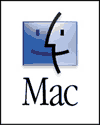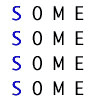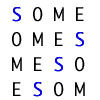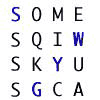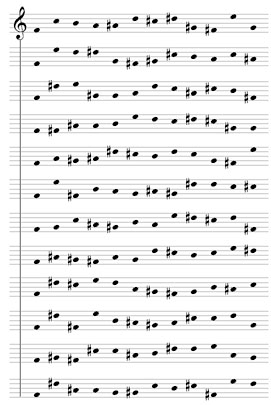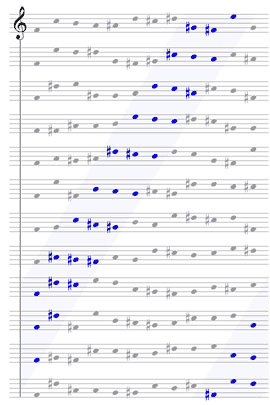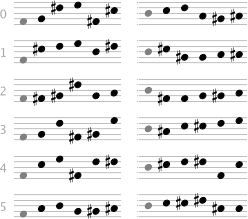
| ||||||||||
|
What's a series? | ||||||||||||||||
A series is a sequence of pitches used as a basic building block to create
serial music. Serial music employs this series in a manner similar to the way that
music of previous centuries used the C-major scale and tonal harmony.
TranspositionTraditional 12-tone music transposed the series to generate a table. If a series had 12 notes, the series was transposed by a half-step 12 times to create a 12x12 table. Spinner does not currently support transposition-generated tables.RotationA second method used by Igor Stravinsky beginning in the 1950s used rotation rather than transposition to emphasize tonal centers. Rather than transposing the series by successive half-steps to generate his tables, he rotated the series then transposed it back to the original starting pitch. This produced the usual 12 permutations, but emphasized the starting pitch. Here's an example of this rotation, using letters instead of notes for clarity: | ||||||||||||||||
| ||||||||||||||||
|
See how this accentuates the letter S? The final table in Step 4
features new letters Q I W K Y U G C A which weren't in the original, but the
letter S dominates the table. If you were to attempt to pronounce the
4-letter words listed in Step 4, you'd start each with an "ess" sound. That
sound is the "tonal center" in Stravinsky's technique.
Here's a sample series taken from Stravinsky's Requiem Canticles:
That starting F is important as a pitch, but the rest of the notes are more important for the intervals they form with their neighbors. In Stravinsky's serial works, intervals and tonal centers constitute the music's basic materials. As an example, let's look now towards the end of the series at the pitches G#-F#-E:
Those three pitches are less important than the two descending major seconds they form. Intervals survive transposition intact, where pitches by definition do not. In traditional tonal music, the pitches are important, the intervals less so. Serial music reverses this. Now let's take the series and generate one of the serial tables. A serial table is a series translated repeatedly to form a grid. The tones specified within the grid are the basic "building blocks" of the work, which often moves freely between the variations.
Notice how those two intervals initially spelled out by G#-F#-E are transposed and rotated leftwards in each line. PermutationsA series has four basic permutations, or alternate forms: prime, inversion, retrograde, and retrograde inversion.Prime is simply the notes spelled out in the their original order. Inversion is prime "upside down". The initial pitch is the same, but the intervals are inverted. A major second up in prime becomes a major second down in inversion. Retrograde is prime backwards. Retrograde Inversion is retrograde "upside down". Another common variation is Inversion Retrograde, which is inversion backwards. Retrograde Inversion and Inversion Retrograde are simple transpositions of each other, differing principally by the emphasis they place on their respective starting notes. HexachordsWhen a series has 12 notes, it's sometimes split in half to create hexachords. The resulting halves are then transformed in miniature to form two 6*6 tables.
Hexachord columns, called verticals, are also used as chords. |
